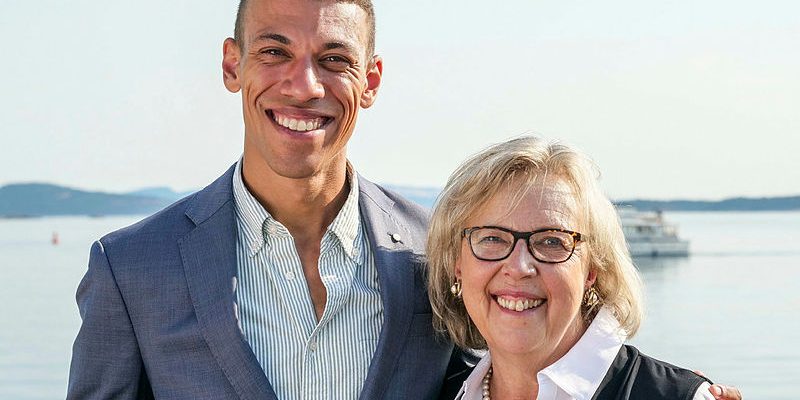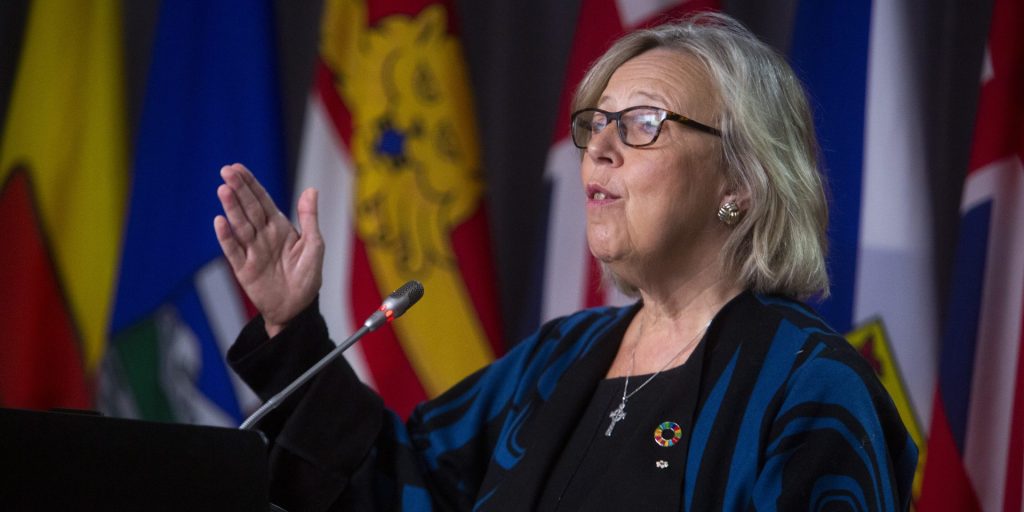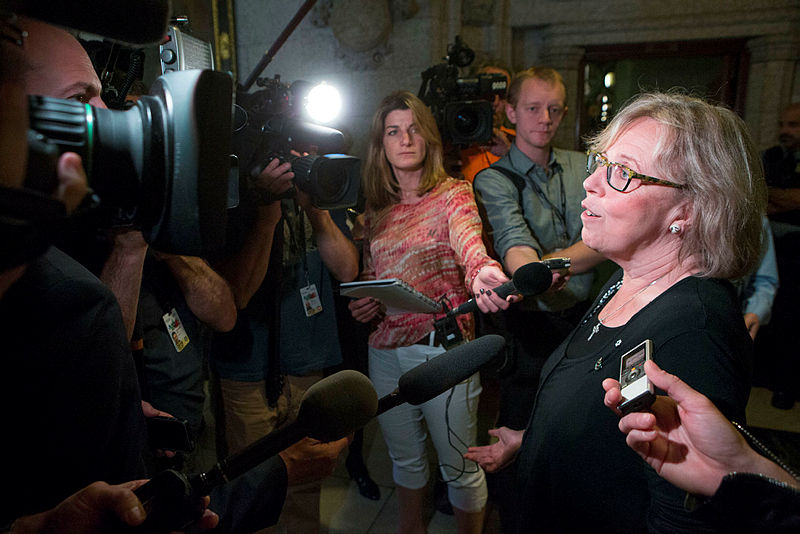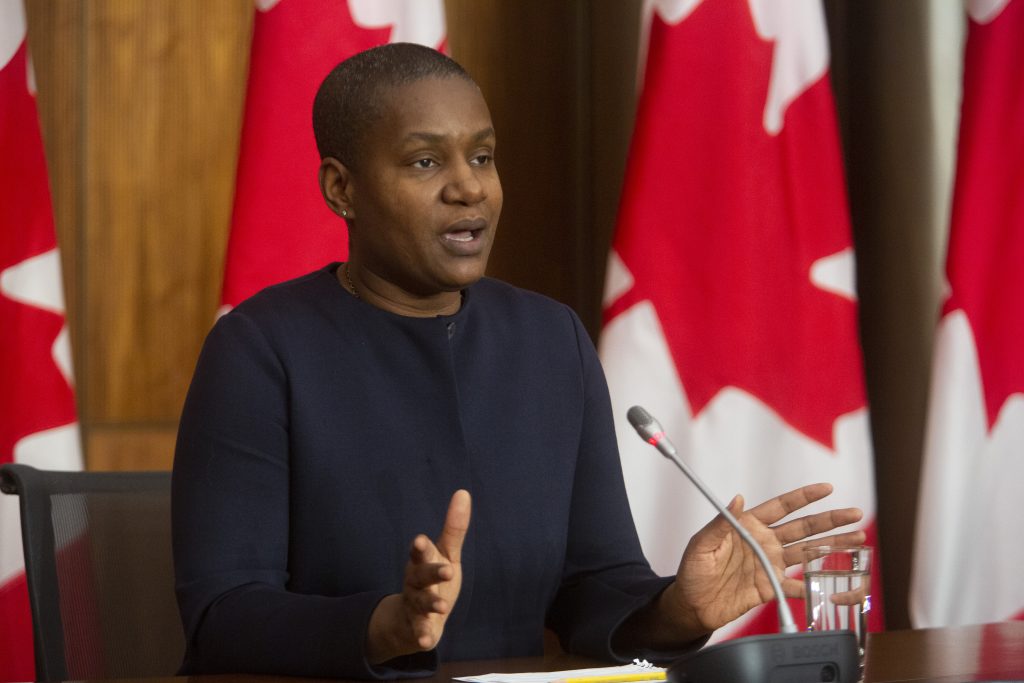May says she’ll lead Greens in a snap election, but wants Pedneault centre stage by 2025

Newly re-elected Green Party Leader Elizabeth May says her “druthers” would be to see running mate Jonathan Pedneault take on prominent activities such as the televised leaders’ debates in the next federal election, if it comes in 2025, but that in the event of a snap election, she is ready to return to the campaign trail.
Meanwhile, Pedneault says that he will not be entering any byelection, and will wait until the general campaign to seek a seat in the House of Commons so he can focus his activities on election readiness in the coming years, while May takes the lead in the House of Commons. He told The Hill Times, when the general election comes he plans to run in his home province of Quebec, despite disappointing results for the Greens in that province in 2021. The next federal election is scheduled for Oct. 20, 2025, but it could happen before then.
May (Saanich-Gulf Islands, B.C.) placed first in the Nov. 19 vote for Green Party leader, winning with 4,666 votes on the sixth ballot. Pedneault finished third, dropping off with 969 votes after the fifth ballot.
The party’s constitution does not presently allow for co-leadership, but having run with Pedneault on a ticket endorsing such a model, May will immediately appoint him as deputy leader, and the duo will seek to amend the party’s constitution so that Pedneault can later be named co-leader.

Two other candidates running as a slate, Anna Keenan and Chad Walcott, placed second and fourth, respectively. Simon Gnocchini-Messier and Sarah Gabrielle Baron, who were each running as individuals, finished fifth and sixth. Candidates promoting co-leadership took a total of 88.32 per cent of the vote on the first ballot.
While the Green Party’s constitution sets out several hurdles to be cleared before implementing a co-leadership model, May said the results are a clear endorsement.
“If we were the only candidates proposing co-leadership, one might say the party wasn’t ready for it. But Keenan and Walcott, who also ran on the proposition of going to co-leadership, did a really credible job and have a lot of support out there,” said May, in an interview with The Hill Times, alongside Pedneault.
Despite that, May recognizes “it’s certainly not a mere formality,” to implement the model, which will have to be passed at two successive Green Party annual general meetings.
Keenan and Walcott, in an interview with The Hill Times, had a similar message.
“I think there is a strong appetite to move towards co-leadership, but the devil will be in the detail of exactly which model of co-leadership we choose to move towards,” said Keenan, who described the party’s choice of the May-Pedneault ticket at one in which the members chose “an option that is stable and familiar.”

“We ran on a vision of renewing the party. We ran on a vision of creating a stronger democracy and modeling a new form of leadership. And we still believe in those things,” added Walcott. “We’re still members of the party, so we’re going to do what we can to support Elizabeth and Jonathan in their leadership, but still see what we can do about turning our vision into reality alongside that.”
For Walcott and Kennan, who have co-chaired the last two Green Party AGMs, part of that means staying involved in discussions about the move to co-leadership.
Keenan noted that many Green parties around the world use co-leadership models, but have significantly different systems, with some having co-leaders run together on a single ticket, while others take the two top rivals for the job and require them to work together.
May said she is looking to models used by the Greens of England and Wales, saying their situation is “the closest one to Canada,” noting they operate in “the same system of Westminster parliamentary democracy,” and, as May described it, “unfortunately for them, as us, the perverse voting system of first-past-the-post.”
For any model to pass, Walcott explained the Greens use a system where proposals at AGMs receive a red, yellow, or green light. A proposal for co-leadership was yellow-lit at the party’s last AGM, meaning members felt it required more time to discuss. That means any proposed model will still need to be green-lit at two future AGMs.
May wants to see Pedneault in 2025 debates
If May and Pedneault can successfully navigate that multi-step process, Canadians may see Pedneault take centre stage in the next election campaign.
“It is clear that the Elections Act anticipates a single leader for things like signing nomination papers,” said May. “So as we get closer to the writ period … we’d make a decision by consensus between the two of us of which one of us would be the primary spokesperson or writ-period face of the party.”

“We’d still be co-leaders, we wouldn’t drop the co-leadership model,” May explained, but one of the co-leaders would take on traditional high-visibility responsibilities, such as appearing in all leaders’ debates.
She said that the party’s federal council, or possibly even the membership, would be consulted on choosing who would step forward, to make sure that members were not “aggrieved” that they had voted for May as leader, and then Pedneault took the lead in a campaign.
May said if the party achieves the kind of electoral readiness, fundraising, by-election victories, and floor crossings she hopes to see transpire over the next three years, seeing her running mate step forward in 2025 is her preferred scenario.
“If I get my druthers and there’s an election in 2025, and we’ve already got a caucus of 12 MPs from by-elections and floor crossings, I’m kind of have a happy camper, and I’d love to see Jonathan take the lead in the writ period,” said May.
However, May is also prepared for a snap election scenario, where she would most likely be the Greens’ primary spokesperson.
“If it’s a snap election that surprises us,” said May, “Jonathan wouldn’t be well known yet. But by 2025, he’ll be very well known.”
In either scenario, May said she is “absolutely committed to running again in Saanich—Gulf Islands,” and “absolutely committed to remaining as co-leader for as long as the party will have us.”
Pedneault plans to wait for general election, run in Quebec
Pedneault has no plans on entering the House of Commons before the next federal election. Instead, he intends to work on election preparations across the country, while May focuses her energies on Parliament.

When the campaign comes, he plans to run in his home province of Quebec, even though—based on results from the last election—there are no obvious seats for him to consider.
In the 2021 federal campaign, the Green Party’s best showing in the province of Quebec came in Notre-Dame-de-Grâce—Westmount, where Green candidate Sam Fairbrother took 4.02 per cent of the vote, losing to Liberal MP Marc Garneau, who took 53.76 per cent. That was the only riding in the province where the Greens crested the four-per-cent mark, with most of their vote shares in the range of one to three per cent.
In 22 of Quebec’s 78 ridings, the Greens did not field a candidate.
That lack of candidates in 2021 is one of the reasons why Pedneault argued there is “no point in looking at numbers from the last election.”
“We have new leadership,” said Pedneault, “and we’re going to have a full slate [of candidates],” added May.
Running without a full slate in 2021 despite many interested Greens who “were ready, able, and willing to run in every riding across the country” was a “mistake” that May said the Greens would not make “ever again.”
In that campaign, former Green Party leader Annamie Paul was criticized for making a third attempt at winning Toronto Centre, Ont., rather than seeking a seat where the party had a greater chance of electoral success. (Paul had previously sought the same seat in the 2019 general election, before she was leader, and in a 2020 by-election, after becoming leader.)
May also made an ill-fated attempt to win a seat in the 2008 election in the riding of Central Nova, N.S., running against then-Conservative cabinet minister Peter MacKay, before relocating across the country to Saanich-Gulf Islands, B.C., a riding identified as one of her best chances at getting in Parliament.

When asked if, based on Paul’s experience in Toronto, he should consider looking farther from home for a more winnable riding, Pedneault rejected the comparison, saying, “The good news is, I’m not Annamie Paul.”
“I do think, and so does our team, and so does our party, that we can do gains in Quebec,” said Pedneault. “I’m Québécois, francophone, from Lac Saint Jean. I have deep roots in the province. I think we lacked that sometimes in the past.”
Pedneault said he hopes to see the four other leadership candidates run in the next election—something which Keenan and Walcott confirmed they were open to. He said he and May have been meeting with potential candidates following the leadership race.
“We need to get out there and focus not on internal party issues, but on the policies that we have to present to all Canadians,” said Pedneault. “I’ll be traveling throughout the country over the next several months, and I hope to carry that message with me, and hopefully, we’ll have Chad and Anna join on some of these tours as well.”
The Hill Times






 LICENSING
LICENSING PODCAST
PODCAST ALERTS
ALERTS













